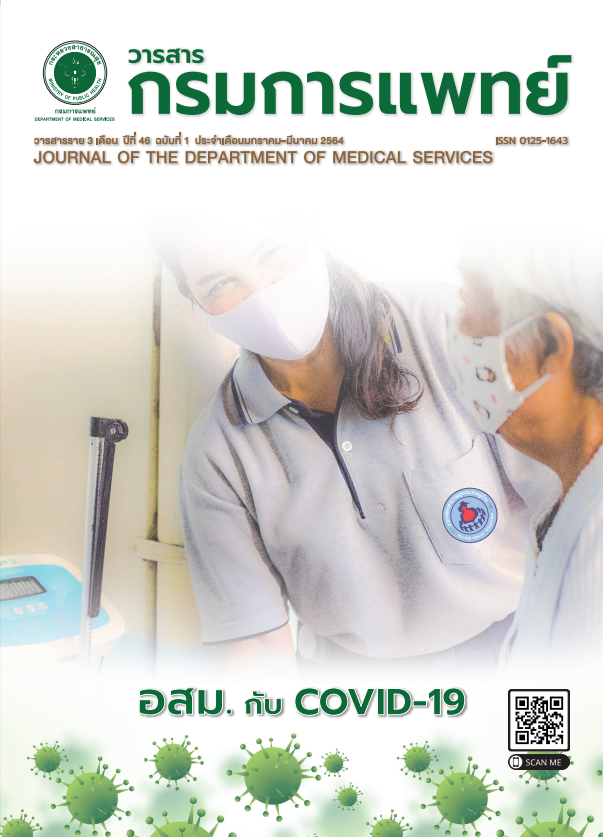Case Series Report of Tuberculous Lymphadenitis: Role of Coordinator and Sample Handling Protocols for Diagnosis by Fine Needle Aspiration Approach
Keywords:
FNA, TB lymph node, Diagnosis, PCR for TB, Culture for TBAbstract
Tuberculous lymphadenitis is manifested by enlarged nodes that mostly affect cervical nodes. Differential diagnosis for lymphadenopathy is diverse. Fine needle aspiration biopsy (FNAB) has been accepted as minimal invasive approach. However, the cytology from FNAB cannot give definitive diagnosis of tuberculosis. Culture, the gold standard diagnostic tool, is limited from small tissue sample and time-consuming. The optimum sample handling protocol is lacking. PCR and Acid-fast stain to detect the microorganism can perform with smears on the cytology slides, sound beneficial. The procedures have not been standardized either. Due to a train of diagnosis tests, a person as patient tests coordinator is merited. The authors therefore reported herewith the cases that underwent our protocol of sample handing and having a coordinator to facilitate the tests done and the results ready on time when the patients had a visit schedule with clinicians. Upon cytology suspected tuberculous lymphadenitis, one smeared slide would re-stained according to routine acid- fast stain method. Another smeared slide would be tested with PCR-based for M. tuberculosis complex. The patients were called for re-FNAB and the samples put directly into a media for culture of M. tuberculosis with automation method. On the patients visited to the clinicians, usually within two weeks, all relevant results – cytology, acid fast stain, PCR were available for the clinicians for treatment or further management plan. The results of culture were accomplished in 4 weeks ready for the clinicians to modify the treatment if indicated. Though all the cases in this report had received a good care and recovered from the diseases, not every case had an uneventful course. The individual clinical course of 10 patients would be present in this case series report. Lastly, aspects of diagnostic challenge were listed and discussed.
References
Gupta PR. Difficulties in managing lymph node tuberculosis.Lung India 2004; 21:50-3.
Sun L, Zhang L, Yang K, Chen XM, Chen JM, X J et al. Analysis of the causes of cervical lymphadenopathy using fine-needle aspiration cytology combining cell block in Chinese patients with and without HIV infection. BMC Infect Dis 2020;20:224.
Purohit M, Mustafa T. Laboratory diagnosis of extra - pulmonary tuberculosis (EPTB) in resource-constrained setting: state of the art, challenges and the needs. J Clin Diag Res 2015; 9:EE01-6.
Krishna M, Gole SG. Comparison of conventional Ziehl-Neelsen method of acid-fast bacilli with modified bleach method in Tuberculous lymphadenitis. J Cytol 2017; 34:188-92.
Goel MM, Ranjan V, Dhole TN, Srivastava AN, Kushwaha MR,Mehrotra A, et al. Polymerase chain reaction vs.conventional diagnosis in fine needle aspirates of tuberculous lymph nodes.Acta Cytol 2001; 45:333-40.
Global tuberculosis report 2019. Geneva : WHO; 2019.
Inoue M, Tang WY, Wee SY, Barkham T. Audit and improve! Evaluation of a real-time probe-based PCR assay with internal control for the direct detection of Mycobacterium tuberculosis complex. Eur J Clin Microbiol Infect Dis 2011; 30:131-5.
Asano S. Granulomatous Lymphadenitis. J Clin Exp Hematop 2012; 52:1-16.
Sampatanukul P, Lertpocasombat K, Tonsakulrungruang K,Udompanich V. Cytologic features of tuberculosis manifesting palpable lumps: a fine-needle aspiration biopsy approach. Chula Med J 1993; 37:119-25.
Kent PT, Kubica GP. Public health mycobacteriology: a guide for the Level III Laboratory. US Department of health and human services, centers for disease control, Atlanta;1985.
Forbes BA, Sahm DF, Weissfeld AS. Mycobacteria. In: Forbes BA, Sahm DF, Weissfeld AS. eds., Bailey & Scott,s Diagnostic microbiology 12th ed. St. Louis, Missouri : Mosby; 2007.
Winn WC, Allen SD, Janda WM, Koneman EW, Procop GW,Schreeckenberger PC, et al. Mycobacteria. In: Winn WC. et al. eds.Koneman,s color atlas and textbook of diagnostic microbiology 6th ed. Philadelphia : Lippincott Williams & Wilkins; 2006.
Siddiqi SH, Rusch-Gerdes S. MGITTM Procedure Manual; Becton,Dickinson &Company (BD); 2006.
Downloads
Published
How to Cite
Issue
Section
License

This work is licensed under a Creative Commons Attribution-NonCommercial-NoDerivatives 4.0 International License.
บทความที่ได้รับการตีพิมพ์เป็นลิขสิทธิ์ของกรมการแพทย์ กระทรวงสาธารณสุข
ข้อความและข้อคิดเห็นต่างๆ เป็นของผู้เขียนบทความ ไม่ใช่ความเห็นของกองบรรณาธิการหรือของวารสารกรมการแพทย์



